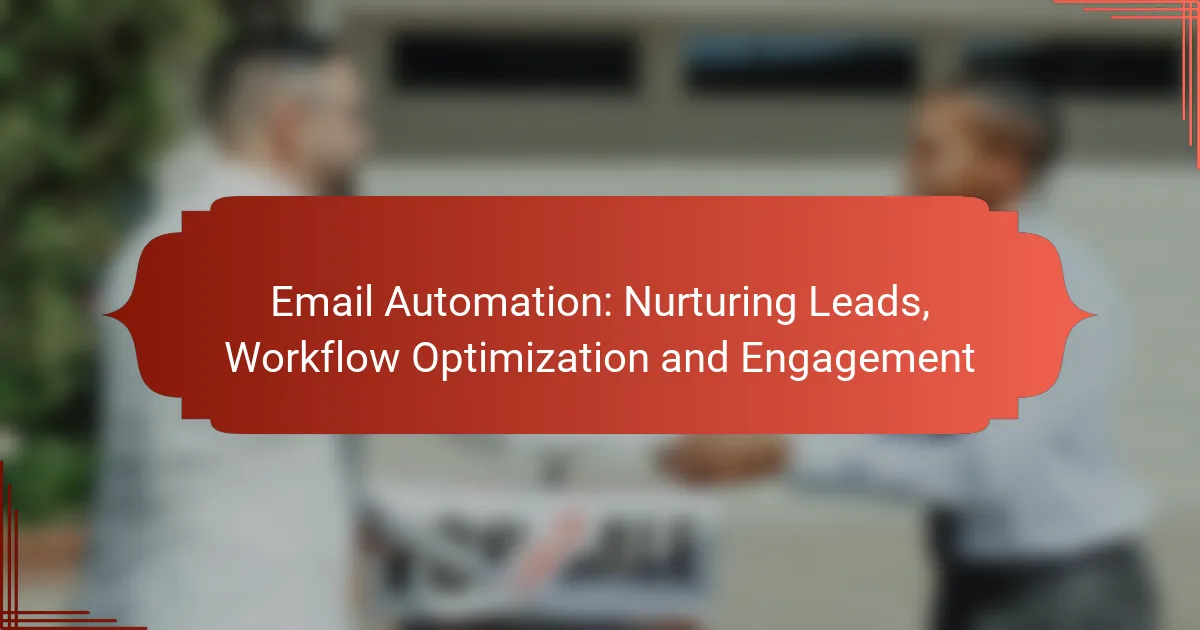Email automation is a powerful strategy for nurturing leads by delivering timely and relevant content that engages potential customers throughout their buying journey. By streamlining communication and automating repetitive tasks, businesses can build stronger relationships, optimize workflows, and ultimately guide leads toward informed purchasing decisions.

How does email automation nurture leads in the UK?
Email automation nurtures leads in the UK by delivering timely, relevant content that engages potential customers throughout their buying journey. It streamlines communication, allowing businesses to build relationships and guide leads toward making informed purchasing decisions.
Personalized email campaigns
Personalized email campaigns are tailored to individual preferences and behaviors, making them more effective in engaging leads. By using data such as past interactions and demographic information, businesses can create targeted messages that resonate with recipients.
For example, a UK-based retailer might send personalized product recommendations based on a customer’s previous purchases. This approach can significantly increase open and click-through rates, ultimately leading to higher conversion rates.
Lead scoring integration
Lead scoring integration helps prioritize leads based on their engagement and likelihood to convert. By assigning scores to leads based on their interactions, such as email opens and website visits, businesses can focus their efforts on the most promising prospects.
In the UK, companies often use lead scoring systems that incorporate criteria like demographic fit and behavioral data. This allows for more strategic follow-ups and resource allocation, ensuring that sales teams spend time on leads with the highest potential.
Automated follow-ups
Automated follow-ups ensure that no lead falls through the cracks by sending timely reminders and additional information. This process can be triggered by specific actions, such as a lead downloading a resource or abandoning a shopping cart.
For instance, a UK service provider might set up an automated email to follow up with leads who attended a webinar, offering them a special discount on related services. This consistent engagement helps maintain interest and encourages leads to take the next step in their journey.

What are the best email automation tools for lead generation?
The best email automation tools for lead generation streamline the process of nurturing leads through targeted campaigns and workflows. These tools help businesses engage potential customers effectively, improving conversion rates and overall marketing efficiency.
HubSpot
HubSpot is a comprehensive marketing platform that offers robust email automation features tailored for lead generation. It allows users to create personalized email campaigns based on user behavior and preferences, which can significantly enhance engagement.
With HubSpot, you can segment your audience and automate follow-up emails, ensuring timely communication. The platform also provides analytics to track performance, helping you refine your strategies over time.
Mailchimp
Mailchimp is widely recognized for its user-friendly interface and effective email automation capabilities. It enables businesses to set up automated workflows that trigger based on specific actions, such as signing up for a newsletter or abandoning a cart.
Mailchimp’s features include customizable templates and A/B testing options, allowing you to optimize your campaigns for better results. It’s particularly suitable for small to medium-sized businesses looking to enhance their lead nurturing processes.
ActiveCampaign
ActiveCampaign excels in combining email marketing with customer relationship management (CRM) tools, making it ideal for lead generation. Its automation capabilities allow you to create complex workflows that adapt based on user interactions, ensuring a personalized experience.
This platform offers advanced segmentation and predictive sending features, which can increase open and click-through rates. ActiveCampaign is particularly beneficial for businesses that require a more integrated approach to email marketing and customer engagement.

How can email automation optimize workflows?
Email automation can significantly enhance workflows by reducing manual tasks and improving communication efficiency. By automating repetitive processes, businesses can save time, minimize errors, and ensure timely follow-ups with leads.
Streamlined communication
Email automation facilitates streamlined communication by ensuring that messages are sent at optimal times without manual intervention. This can include welcome emails, follow-ups, and reminders that are triggered based on user behavior or specific timelines.
For example, a business can set up an automated welcome email to be sent immediately after a lead subscribes to a newsletter. This not only improves engagement but also establishes a professional image by maintaining consistent communication.
Task automation
Task automation within email workflows can help teams focus on strategic activities rather than repetitive tasks. By automating actions such as lead scoring, segmentation, and follow-up reminders, businesses can enhance productivity.
Consider using automation tools to schedule emails based on user interactions. For instance, if a lead opens an email but doesn’t click on a link, an automated follow-up can be triggered to encourage further engagement.
Integration with CRM systems
Integrating email automation with Customer Relationship Management (CRM) systems allows for a seamless flow of information. This integration ensures that all customer interactions are logged and accessible, enhancing the ability to personalize communication.
For instance, when a lead interacts with an automated email, that data can be automatically updated in the CRM, allowing sales teams to tailor their follow-up strategies based on real-time insights. This synergy maximizes the effectiveness of both email campaigns and sales efforts.

What are the key metrics for measuring email engagement?
Key metrics for measuring email engagement include open rates, click-through rates, and conversion rates. These metrics provide insights into how effectively your emails are resonating with your audience and can guide improvements in your email marketing strategy.
Open rates
Open rates indicate the percentage of recipients who opened your email compared to the total number of emails delivered. A typical open rate can vary widely, often falling between 15% to 30%, depending on the industry and audience. Monitoring this metric helps you assess the effectiveness of your subject lines and sender reputation.
To improve open rates, consider personalizing subject lines and optimizing send times based on your audience’s behavior. Avoid spammy phrases that could trigger filters, and ensure your email list is clean and targeted.
Click-through rates
Click-through rates (CTR) measure the percentage of recipients who clicked on one or more links within your email. A good CTR typically ranges from 2% to 5%, but this can vary by sector. This metric reveals how compelling your content and calls-to-action are to your audience.
Enhancing CTR can be achieved by using clear and engaging calls-to-action, segmenting your audience for tailored content, and ensuring your email design is mobile-friendly. Regularly testing different formats and content types can also yield valuable insights.
Conversion rates
Conversion rates reflect the percentage of recipients who completed a desired action after clicking through your email, such as making a purchase or signing up for a webinar. This metric is crucial for measuring the overall effectiveness of your email campaigns in driving business goals. Typical conversion rates can range from 1% to 5%, depending on the offer and audience targeting.
To boost conversion rates, ensure your landing pages are relevant and optimized for user experience. A/B testing different offers and designs can help identify what resonates best with your audience. Additionally, follow up with segmented emails to nurture leads who clicked but did not convert.

What criteria should be considered when choosing an email automation platform?
When selecting an email automation platform, consider factors such as scalability, user interface, and customer support. These elements will significantly impact your ability to nurture leads effectively and optimize workflows.
Scalability
Scalability refers to the platform’s ability to grow with your business needs. A good email automation tool should handle increasing volumes of emails and contacts without compromising performance. Look for platforms that offer tiered pricing plans, allowing you to upgrade as your requirements expand.
For example, if you start with a few hundred subscribers and anticipate growth into the thousands, choose a service that can accommodate this change seamlessly. Avoid platforms that impose strict limits on the number of emails sent or contacts managed, as this can hinder your marketing efforts.
User interface
The user interface (UI) of an email automation platform should be intuitive and easy to navigate. A well-designed UI allows users to create campaigns, segment lists, and analyze results without extensive training. Look for drag-and-drop features and customizable templates that simplify the email creation process.
Consider testing the platform with a free trial to assess its usability. A confusing interface can lead to errors and wasted time, so prioritize platforms that offer a smooth user experience and clear documentation.
Customer support
Reliable customer support is crucial when using an email automation platform. Ensure that the provider offers multiple support channels, such as live chat, email, and phone support, to assist you when issues arise. Fast response times and knowledgeable staff can make a significant difference in resolving problems quickly.
Check for user reviews and testimonials regarding customer service experiences. A platform with strong support can help you troubleshoot issues and optimize your email campaigns effectively, while poor support can lead to frustration and lost opportunities.

What are the common pitfalls in email automation?
Common pitfalls in email automation include over-automation and neglecting segmentation, which can lead to ineffective campaigns and disengaged audiences. Understanding these issues helps marketers optimize their strategies for better engagement and conversion rates.
Over-automation
Over-automation occurs when businesses rely too heavily on automated systems, resulting in impersonal communication. This can alienate recipients who prefer a more personalized touch in their interactions.
To avoid over-automation, ensure that automated emails still reflect your brand’s voice and maintain a human element. For example, consider adding personalized greetings or tailored content based on user behavior.
Regularly review your automated workflows to identify areas where human intervention might enhance the customer experience. Striking the right balance between automation and personal engagement is crucial for maintaining relationships.
Neglecting segmentation
Neglecting segmentation means sending the same message to your entire email list, which can lead to lower engagement rates. Effective segmentation allows you to tailor your messages to specific audience groups, increasing relevance and response rates.
To implement segmentation, categorize your audience based on factors such as demographics, purchase history, and engagement levels. For instance, you might send promotional offers to frequent buyers while providing educational content to new subscribers.
Utilize tools that allow for dynamic content within emails, enabling you to customize messages based on the recipient’s profile. This approach can significantly enhance the effectiveness of your email campaigns and foster better connections with your audience.
